AWAM Rules Engine Plug-In
The AWAM Rules Engine plug-in works with Window Book’s AWAM; specifically, AWAM FM(Rules Manager). The plug-in is responsible for automatically detecting new Mail.dat files in a single import hot folder or a sub-folder one level down from that hot folder. The plug-in then works in conjunction with the Rules Manager and applies rules created by the Mailer against the Mail.dat files. For example, if the data in a Mail.dat triggers a specific rule (matches the rule’s criteria). In that case, the Mail.dat is automatically moved to the folder associated with the AWAM profile specified in that rule. The Mail.dat is then imported into DAT-MAIL using AWAM, based on the criteria and rules defined within that corresponding profile.
If a Mail.dat does not trigger a specific, ‘normal’ rule, a ‘default’ rule is initiated, and the plug-in moves the Mail.dat to the folder specified in AWAM’s/DAT-MAIL’s default profile.
In addition, Mailers can create a ‘reject(s)’ rule that will not import Mail.dat files into DAT-MAIL. In this case, if a Mail.dat triggers a ‘reject’ rule, the file is automatically moved into a folder specified by you.
If you need to modify a rule in AWAM FM, stop this plug-in first in the Scheduler. Do not stop the Scheduler’s service, but stop the plug-in itself. You can do this by going into the plug-in’s Expert View screen and adding an end date (refer to step 2 in the procedure below for a screen image reference). Once the editing of the rule is complete, remember to remove the end date in the plug-in’s Expert View screen so that the plug-in will resume its normal function.
To configure the AWAM Rules Engine plug-in, do the following:
-
Open Scheduler and
 Stop the Service.
Stop the Service. -
Click AWAM Rules Engine on the left.
The Select Configuration screen will display.
Select the Expert View checkbox and click Next to continue.

-
The Expert View screen will display. Enter a
 Name specific to the configuration being created and specify when and how often the plug-in’s process will run. Click Next to continue.
Name specific to the configuration being created and specify when and how often the plug-in’s process will run. Click Next to continue.Window Book does not recommend enabling the function to Run at start-up unless directed by a Window Book Support representative. However, if this option is enabled and the Scheduler is stopped and started for whatever reason, the plug-in will run every time the Scheduler starts regardless of the plug-in’s frequency settings.
Below the print screen is an explanation:
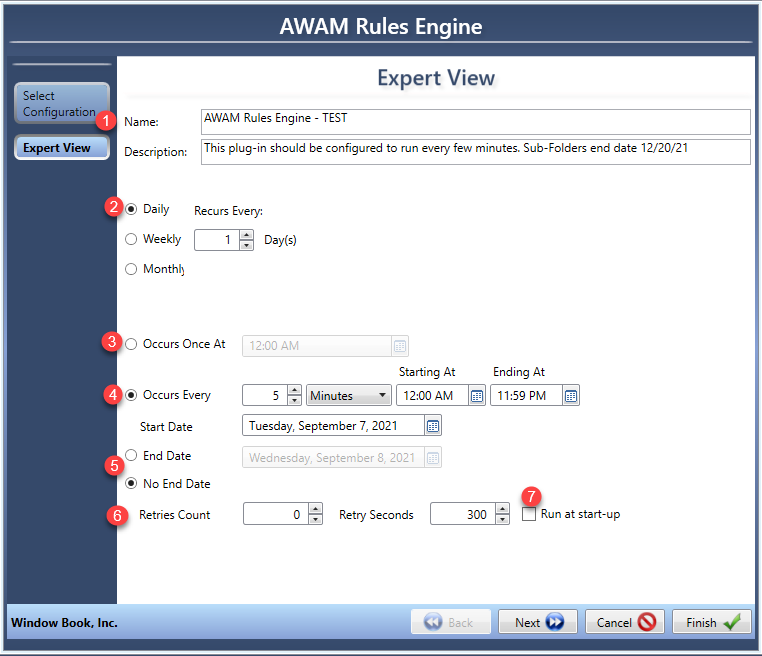
 Recurs every: The default is Daily; leave this setting unless you prefer not to have the Scheduler running every day, then you could change it to Weekly and select the days of the week it should be looking for Mail.dats.
Recurs every: The default is Daily; leave this setting unless you prefer not to have the Scheduler running every day, then you could change it to Weekly and select the days of the week it should be looking for Mail.dats. Occurs Once At: If you only want to look for Mail.dats once a day at a set time, you would select the time here.
Occurs Once At: If you only want to look for Mail.dats once a day at a set time, you would select the time here. Occurs Every: The default is 5 minutes and the Starting At 12:00 AM and Ending At 11:59 PM. You can adjust to suit your environment. For example, if you run a nightly backup, you change the Starting At and Ending At to ensure the Scheduler is not running.
Occurs Every: The default is 5 minutes and the Starting At 12:00 AM and Ending At 11:59 PM. You can adjust to suit your environment. For example, if you run a nightly backup, you change the Starting At and Ending At to ensure the Scheduler is not running. End Date and No End Date: The default is No End Date. If you are using this configuration for a specific project and after this time you do not want this configuration to run, you could set an End Date.
End Date and No End Date: The default is No End Date. If you are using this configuration for a specific project and after this time you do not want this configuration to run, you could set an End Date.  Retries Count and Retry Seconds: Unless a Window Book Support Representative asks you to set a retry count and wait (seconds) until it tries again, please do not change.
Retries Count and Retry Seconds: Unless a Window Book Support Representative asks you to set a retry count and wait (seconds) until it tries again, please do not change. Run at Startup: Never select this option unless a Window Book Support Representative asks you to do so.
Run at Startup: Never select this option unless a Window Book Support Representative asks you to do so. -
The General screen will display. You can select or create a single main folder that acts as a hot folder that the AWAM Rules Engine plug-in will monitor for incoming Mail.dat files, or this same folder can contain sub-folders. If using subfolders, select the Subfolders of selected folder radio button. Next, click Browse to select the Input folder. When finished, click OK to close the dialog.
In a server-with-workstations environment, use UNC paths when specifying file folders. In addition, create/use file folders located within a shared and available directory. For example, Window Book recommends creating folders within the main ‘WB’ directory. For assistance with UNC Paths, see the Support Portal Knowledge Base - https://windowbook.na2.teamsupport.com/knowledgeBase (login is required).
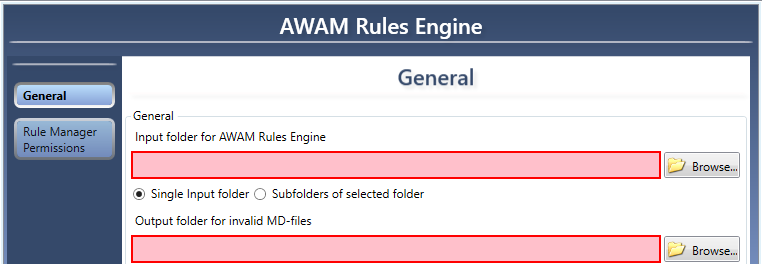
-
The General screen will again display. You can select or create a single input folder that acts as a hot folder that the AWAM Rules Engine plug-in will monitor for incoming Mail.dat files, or this same folder can contain sub-folders. If using subfolders, select the Subfolders of the selected folder radio button. Next, click Browse to select the Input folder. When finished, click OK to close the dialog.
If the option to monitor sub-folders is selected, you can enter a cut-off date. Mail.dat files identified by the plug-in in the sub-folders that are older than the date entered will be ignored by the AWAM Rules Engine plug-in. Next, enter a date or click the calendar icon to select a date.
The cut-off date applies to sub-folders only. It does not apply to the single input folder.
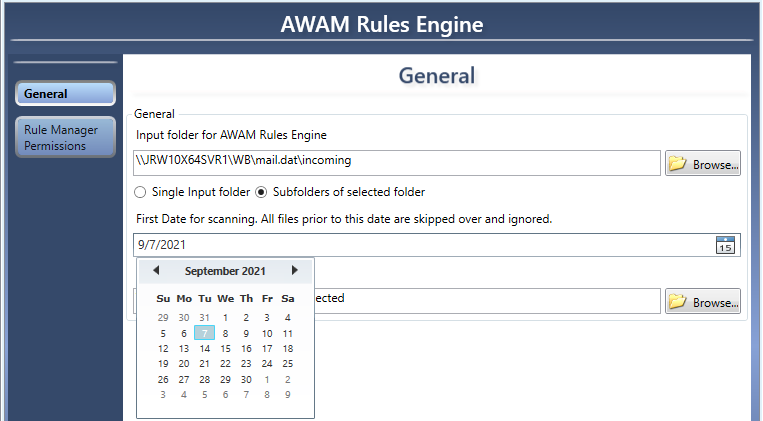
Click Browse to select an output folder to be used for Mail.dat files that are invalid or should not be imported into DAT-MAIL based on the rules set. Once the folder is selected, click OK to close the Browse for Folder dialog. The General Screen will display the chosen folder. Click Next to continue.
Again, in a server-with-workstations environment, use a UNC path for the Output folder. In addition, the folders must be within a directory that is shared and available to all users/systems. For example, Window Book recommends creating folders within the main ‘WB’ directory.
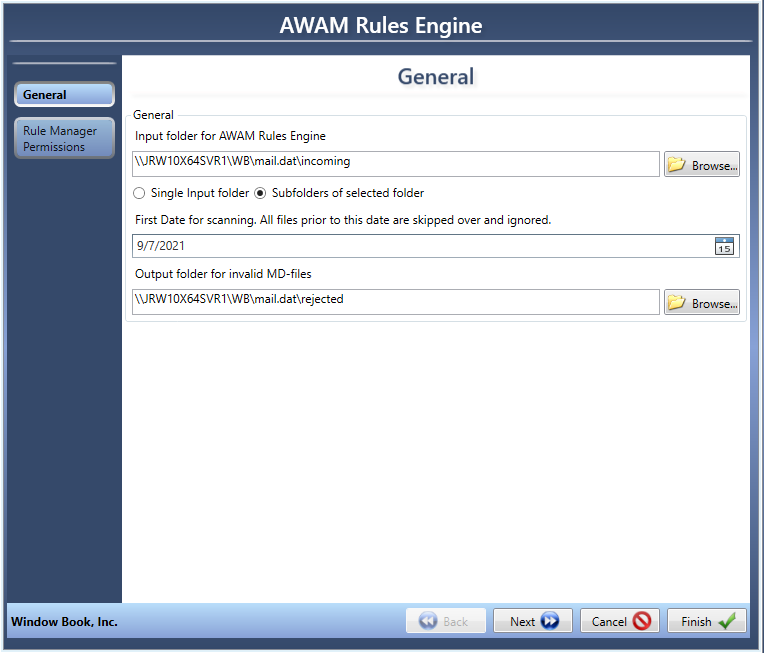
-
The Rule Manager Permissions screen will display. It provides access or rights control over the AWAM Rules Manager. The permissions consist of view only and full access. Users automatically receive view-only rights. Their corresponding Domain and User Name information are required to gain full access rights. Users with full access rights will be able to add, modify, and delete rules.
Take care to grant full access rights to only qualified individuals. Modifying existing rules or adding or deleting rules can significantly impact production and cause unwanted or unexpected system behavior.
To add a user, click the area on the screen labeled Click here to add new item.

Enter the Doman/Machine Name and the Username associated with the account. Click anywhere on the screen for the entry to be activated. After finished adding users, click Finish.
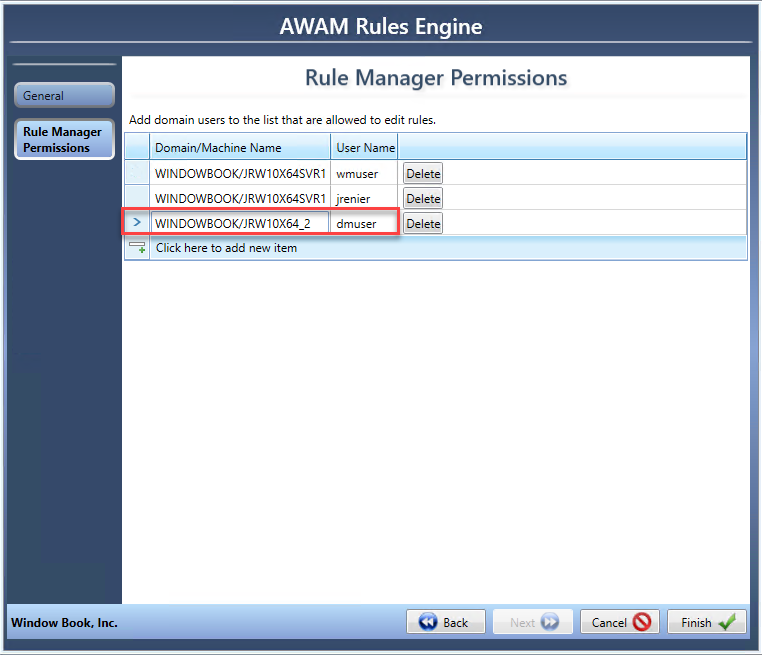
-
The Finished screen will display.
If you do not have other plug-ins to set up, click
 Start the service, and the Scheduler can be closed.
Start the service, and the Scheduler can be closed. 

Plug-Ins Available